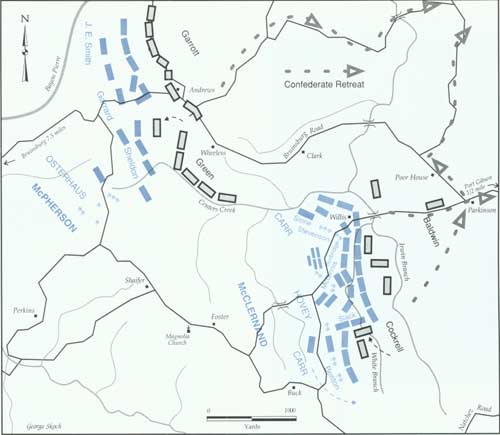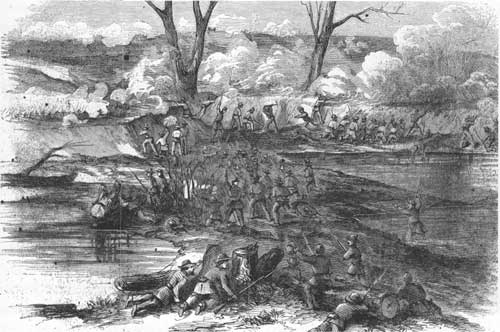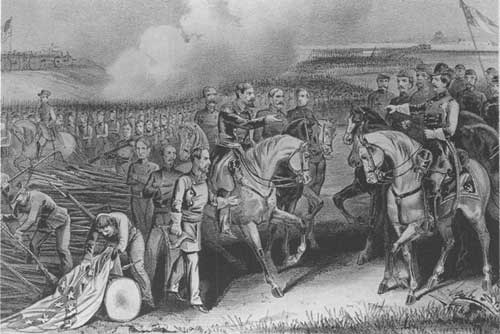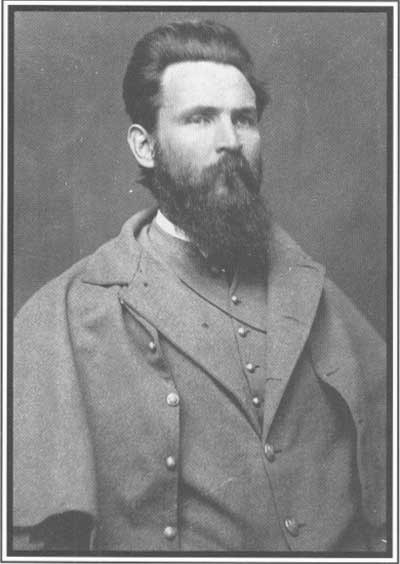|
As the light of dawn streaked through the tangled woodland, Union
commanders looked upon the surrounding landscape in astonishment. All
around they saw a maze of thick canebrakes, crisscrossing ravines, steep
valleys, and broad and narrow ridges complicating any plans of
attack.
General McClernand arrived at dawn and was briefed on the situation.
He learned that a road veering northwest from the Shaifer house
ultimately led to the Bruinsburg road. A local black man warned
McClernand that Confederate troops (Tracy's Alabamians) were approaching
from that direction. McClernand sent Peter Osterhaus's division to meet
this threat on the Union left flank.
Meanwhile, Tracy got an urgent message to send a regiment and a
section of artillery to reinforce the hard-pressed Green on the Rodney
road. At this point, the Rebels had only 2,500 men present on the field;
cooperation between Tracy's and Green's widely separated wings was
essential but difficult because of the terrain.
Help was on the way. William Baldwin rushed his brigade forward to
the fight. The Missouri brigade, led by able Colonel Francis Cockrell,
waited impatiently at Grand Gulf. Bowen had been unwilling to gamble
that Grant had given up the idea of crossing at Grand Gulf. Once he
arrived on the battlefield about 7:30 A.M., Bowen recognized his error.
A courier raced to Grand Gulf with orders for the Missourians to hurry
to Port Gibson.

|
BRIGADIER GENERAL PETER J. OSTERHAUS. (NA)
|
While the Confederates waited for reinforcements, Osterhaus pressured
Tracy's wing, using his superiority in numbers to great effect. The
timely arrival of another Alabama regiment from Vicksburg helped, but
suddenly the Rebels suffered a crisis in leadership. Tracy fell dead
from a Union sharpshooter's bullet. Colonel Isham Garrott assumed
command but had no idea of Tracy's battle plan. Garrott asked for
instructions from Green and received a vague reply to maintain his
position "at all hazards."
Osterhaus continued to extend his line in both directions, but
Garrott's men, thanks to their tenacity and geographical factors,
thwarted Yankee attacks. Finally, Osterhaus decided on a thrust at the
Confederate right while massing for an all-out assault on Garrott's
center. Then Osterhaus hesitated and waited until Grant, who had arrived
at the front, sent a brigade from Logan's division.

(click on image for a PDF version)
|
BATTLE OF PORT GIBSON, MAY 1, 1863, 8:15 A.M. TO 10 A.M.
The action opens as John McClernand's corps bumps into Martin Green's
Confederates posted around Magnolia Church. Peter Osterhaus's division
moves to meet Confederates commanded by Edward Tracy. Though Tracy is
soon killed, his successor, Colonel Isham Garrott, holds the troops
together and stops Osterhaus until late in the afternoon. A. P. Hovey's
and Eugene Carr's divisions struggle with Green's Rebels around Magnolia
Church. After much bloody fighting, the outnumbered Green falls back to
Centers Creek.
|
On the Rodney road, General Green's small force had been routed by
Carr's and A. P. Hovey's divisions. Two cannon from the Virginia
Boutetort Artillery had been lost (the Virginia artillerymen were the
only participants from that state in the Vicksburg campaign) as well as
a caisson and 200 prisoners. Although the terrain had aided Green's
stand near the Magnolia Church ridge, he had been heavily outnumbered.
Bowen sent Green's shattered command to the right wing to help
Garrott.
General Baldwin's brigade arrived from a forced march through a
chaotic Port Gibson to take up the fight for the Confederates on the
Rodney road. Cockrell's Missourians made a quick march from Grand Gulf
and waited in reserve on Baldwin's wing. Bowen now called in all his
troops guarding the Bayou Pierre and Big Black waterways.
On the Bruinsburg road, Osterhaus renewed his attacks on Garrott,
gradually caving in the Rebel right flank. At 5 P M Green, senior
commander on the scene received a message from Bowen to hold out until
sunset. If Green could not take the offensive by then, he could retreat.
Green, aware the day was lost, thought sunset was close enough and
ordered a withdrawal.
The 6th Missouri Confederate regiment, isolated from the other
commands on the Bruinsburg road, narrowly escaped being captured during
the retreat. By faking an attack, most of the Missourians managed to
escape, although the 49th Indiana recognized the ruse in time to bag 46
prisoners. The rest of Green's command retreated across Bayou Pierre
toward Grand Gulf.

(click on image for a PDF version)
|
BATTLE OF PORT GIBSON, MAY 1, 1863, 11 A.M. TO 5:30 P.M.
Green's troops are sent to reinforce Garrott. Federals are reinforced by
Logan's division of McPherson's corps. Around 5 P.M. a Federal attack
forces Bowen to order Garrott and Green to pull back. On Bowen's left
flank Baldwin takes up the fight after Green's retreat. Cockrell and his
Missourians go to the left of Green's line and punish Slack's troops
along the White Branch of Centers Creek. Infantry from Smith's division
and Hovey's artillery stop Cockrell. The retreat on the Confederate
right had begun, and Baldwin and Cockrell withdraw.
|
While victory had finally come on the Union left, McClernand's blue
column on the right had encountered stubborn opposition after Green's
defeat. McClernand and Richard Yates, the governor of Illinois, along to
observe the battle, had made political speeches before Grant quietly
urged pursuit of the retreating Confederates. The Yankee pause gave John
Bowen valuable time.
On the Rodney road, Bowen anchored his new defensive line in front of
a narrow ridge between the White and Irwin branches of Willow Creek.
Bowen had decided that he would develop his defense in this lower
terrain after observing the action on the broad Magnolia Church ridge.
There his troops had been susceptible to artillery fire. Down in the
bottom, the ravines and vegetation gave the Confederates better
cover.

|
THE SIXTH MISSOURI (C.S.A.) REGIMENT FOUGHT BRAVELY THROUGHOUT THE
VICKSBURG CAMPAIGN. THEY ARE SHOWN HERE FIGHTING OUTSIDE VICKSBURG. (LC)
|
Bowen's strategy worked for several hours as the battle along the new
Rebel defensive line developed into a bloody stalemate. But Bowen feared
that the Federals might extend their lines southward to a road that led
around his position into Port Gibson. He ordered Cockrell's reserve
beyond the Confederate left to assault the Yankee right.
Hovey saw Cockrell's column and tried to get reinforcements to the
danger point. Before he acted, the Missourians attacked, devastating
James Slack's Union brigade. But massed artillery and superior numbers
of Union infantry soon forced the Missourians to retreat grudgingly.
His right secured, McClernand tried to whip Baldwin as he had beaten
Green, with a massed frontal assault. The Confederate position here was
stronger, and Green's and Cockrell's attack had drained some of the
forces McClernand counted on for his attack. So McClernand let the
battle develop on its own, but his numerical advantage, enhanced with
the arrival of two brigades from Logan's division, eventually collapsed
the Rebel left.

|
A THEODORE DAVIS SKETCH OF LOGAN'S DIVISION CROSSING THE BAYOU PIERRE IN
PURSUIT OF THE CONFEDERATES. (LC)
|
Bowen ordered a retreat, and his men escaped north across Bayou
Pierre and its fork, Little Bayou Pierre, firing bridges behind them.
Outnumbered more than three to one, Bowen and his subordinates had
fought brilliantly, delaying Grant from just after midnight until near
sunset of May 1, inflicting 875 casualties on Grant's army while losing
787. The little Confederate force at Port Gibson had bought Pemberton
time; it remained to be seen how well he would use it.
A victorious Grant decided to keep up the pressure while he had
momentum. He had considered turning south to join Nathaniel Banks and
attack Port Hudson. But Banks was currently operating on the Red River
and could not effect a junction for several days. So Grant left Port
Hudson to Banks, who had the Federal XIX Corps, which considerably
outnumbered Rebel defenders.
Pemberton decided to abandon Port Hudson and had wired Franklin
Gardner to rush his forces to Vicksburg. But President Jefferson Davis
intervened, wiring Pemberton, "To hold both Vicksburg and Port Hudson is
necessary to a connection with the Trans-Mississippi." Davis should have
left such a decision to his field commander, and Pemberton, his
confidence badly shaken by the loss of Port Gibson and subsequently
Grand Gulf, should have protested. Pemberton, however, immediately
wired Gardner to remain in the Port Hudson works with 2,000 men (about
5,000 reinforcements later joined Gardner's force).

|
FARRAGUT PASSING THE STEEP RIVERBANKS AT PORT HUDSON. PAINTING BY FRANK
SCHELL AND THOMAS HOGAN. (AMERICAN HERITAGE PICTURE COLLECTION)
|

|
THE SURRENDER OF PORT HUDSON AS ILLUSTRATED IN THIS CURRIER AND IVES
PRINT. (LC)
|
On May 21 Banks's army began siege operations. The siege of Port
Hudson included two desperate assaults by Federal troops, including
Louisiana blacks fighting for the Union, on May 27 and June 11, both of
which were beaten back by equally desperate Rebel defenders.
Confederate operations in Louisiana intended to relieve Port Hudson
failed but kept Union forces occupied and constantly on the alert. A
frustrated Banks could not force a surrender until July 8, four days
after Pemberton's surrender of Vicksburg made Port Hudson untenable.
Grant decided to move north-northeast, feinting toward the Big Black
with his true objective being the Southern Railroad that connected
Jackson and Vicksburg. Once astride this Confederate supply line, Grant
could turn west and attack Vicksburg. Grant marched with two corps,
McClernand's XIII and James McPherson's XVII. Sherman had abandoned his
Snyder's Bluff demonstration and was hurrying his XV Corps to join
Grant. When Sherman arrived, Grant would have a force of some
45,000.
Wagons from a beachhead established at Grand Gulf kept Grant's army
supplied. After the war, Grant originated a myth, perpetuated by many
historians ever since, that when he left Port Gibson and moved toward
central Mississippi he cut his supply line. His army lived off the land,
he said. The truth is that well-supplied wagon trains trailed the army
inland.
A nervous John Pemberton decided that to counter Grant's march, all
Confederate troops must be consolidated west of the Big Black to protect
Vicksburg. Pemberton never considered taking the offensive, despite the
urging of some of his officers. Joseph Johnston had wired Pemberton on
May 1 to unite all his forces to strike Grant, even if that meant
abandoning Vicksburg. The wire gave good advice but arrived too late to
keep Grant from winning at Port Gibson. Pemberton would have ignored
Johnston anyway. President Davis had said to hold Vicksburg, and
Pemberton had learned in South Carolina that if ordered to hold a spot,
he must do so.
When William Loring arrived on the battle front above Port Gibson, he
took command of Confederate forces and led a retreat to the Big Black at
Hankinson's Ferry. Reinforcements from Vicksburg arrived, and Loring had
an opportunity to strike McPherson's corps, temporarily isolated as the
Yankees spread out on a broad front moving northeast. Loring, seemingly
reflecting Pemberton's defensive state of mind, let the chance go
by.

|
BRIGADIER GENERAL JOHN GREGG (NA)
|
Loring led his troops north toward Pemberton's concentration area
between Edwards and the Big Black. Pemberton had received intelligence
reports that Grant was headed for the railroad near Edwards. Pemberton
intended to place his main battle line along the high bluffs on the west
bank of the Big Black.
What if Grant decided to attack Jackson instead? Loring persuaded
Pemberton to send a detachment east just in case. Brigadier General John
Gregg, on his way to reinforce Pemberton from Port Hudson, received
orders to take his brigade of some 3,000 men to Raymond. Gregg was to
keep an eye out for the enemy but not to fight if outnumbered. Pemberton
was risking isolating much needed troops, especially with only a small
number of state cavalry, inexperienced compared to Yankee veterans,
available to screen Gregg's position. Through confusion of orders,
regular Confederate cavalry intended to assist Gregg had been sent in
the wrong direction.
|
